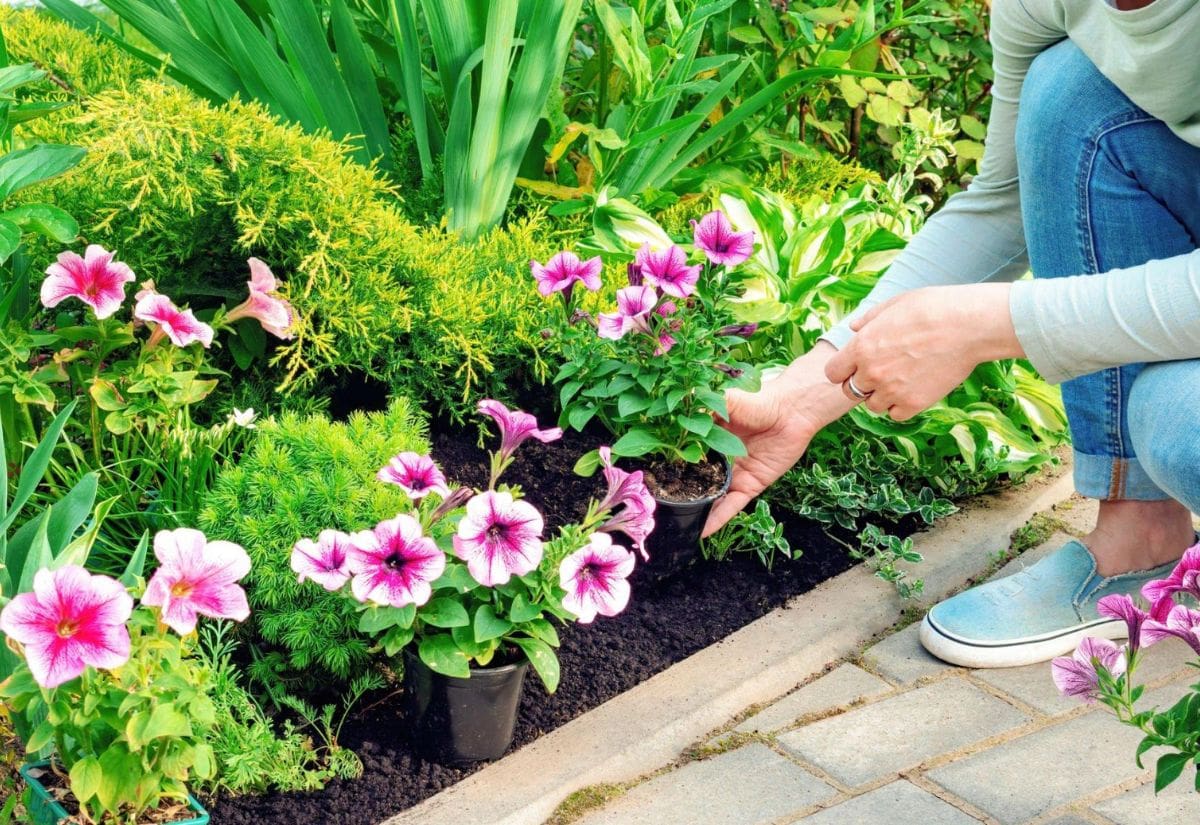
With cheerful blooms that grow in a myriad of vibrant colors, petunias are a go-to flowering plant to add long-lasting appeal to your home from spring to the first frost of the year.
These vibrant annuals are a low-maintenance, hardy option that will flourish in flower beds, hanging baskets, patio containers, or in mass plantings for edging and borders. And as if their charm and versatility aren’t enough, they also attract lots of pollinators to your garden and keep invasive pests at bay by drawing in beneficial insects to snack on them.
While petunias are certainly easy on the eyes all on their own, growing them with complementary plants will further enhance their charm. Companion planting can improve the appearance of your gardens, but also offer lots of other benefits that we’ll talk about soon enough. So, let’s jump in and find out some great companion plants for petunias and 5 to keep your distance from!
Benefits of Companion Planting with Petunias
Companion planting is a widely used practice that involves growing different species of plants together in a garden, container, or hanging basket for a mutual benefit or productivity. Whether deterring pests and disease, promoting soil health, drawing in pollinators, or as a method of weed control, companion planting has a wide range of advantages. And petunias are one of the best flowering annuals to companion plant with.
Petunias are helpful for other plants by acting as magnets to pollinators like butterflies, hummingbirds, and bees that will boost your vegetable yield when planted nearby and also bear the brunt of attack from hungry insects that want to feed on your veggies.
Companion planting will also help you fill in gaps in your garden that weeds will lay claim to and improve the health of the soil by having different root systems in the area and helping hold moisture for your petunias and other nearby plants.
There’s also an aesthetic benefit of companion planting. With flowering plants like petunias, companion planting is often centered around finding plants that will accent one another’s shape for ornamental appeal.
Companion planting uses contrasting heights, textures, and colors that harmonize to create dimension and character in your gardens when planted together. Also used in container planting, the ‘thriller, filler, spiller’ method creates captivating displays through companion planting, with petunias as a perfect filler option.
So whether you’re looking to draw in pollinators or put together a fun mix for your hanging basket, I have no doubt that we’ll find the perfect partner for your petunias.
18 Companion Plants to Pair with Petunias for Perfect Harmony!
Petunias are beautiful flowering plants that are popular not only for their striking blooms, but their hardy nature that makes them a great addition to a low-maintenance flower bed, container, or hanging basket. However, lots of plants aren’t able to handle the relentless hot and dry conditions that petunias thrive in.
The best environment for petunias is an area that receives full sun (6 or more hours of direct sunlight) and has well-draining, neutral to slightly acidic soil. You should also note that petunias actually flourish in drought-like conditions and would rather too little water than too much.
With this in mind, you should only consider companion planting with plants that are acclimated to these harsher conditions, so let’s find out a few of them that will both look great and thrive with your petunias.
1: Snapdragon
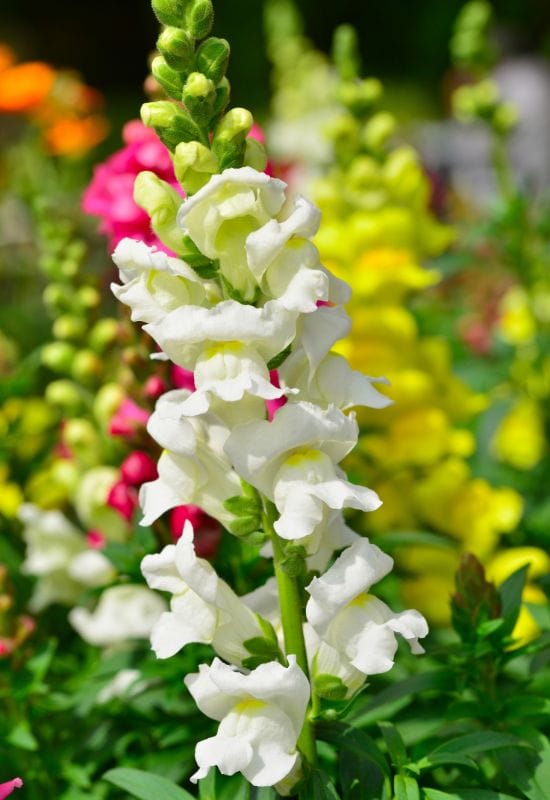
The contrast between the trailing growth of wave petunias and the upright, stately manner of snapdragons make for an eye-catching flower bed that will be teeming with color after spring blooming.
Resembling the snout of a dragon that opens and closes when flowering, snapdragons have colorful, towering blooms that pair beautifully with low-flowing petunias. This combo certainly offers a striking visual appeal, but they also have similar soil and light requirements, making them easy to plant together.
Snapdragons are a favorite for pollinators, but they are also known for attracting ladybugs which can help keep your garden free from too many unwelcome insect visitors.
2: Salvia

Salvia, especially red salvia, and petunias are a classic combination that gardeners favor to draw in pollinators.
Placed behind petunias in flower garden borders or as a thriller plant in containers, salvia have long stalks that make for a charming contrast to wave petunias’ lower growth. I also recommend adding spiked salvia as a thriller plant in the center of your container for added texture, with petunias trailing below. Salvia come in colors of yellow, pink, purple, white, blue and red and bloom at the same time as petunias do.
Not only a vibrant treat throughout the summer months, this combination will keep deer at bay and capture the attention of hummingbirds and butterflies.
3: Lantana

Another long-lasting bloomer, lantana is a great option for companion planting with petunias. Lantanas have more of a mounded growth habit, which has a really pretty cascading effect when planting petunias are them.
Both sun-loving plants that can still bloom in partially shady zones, lantanas and petunias have similar needs that make them easy to grow together.
Aside from the visual appeal, lantanas can protect your petunias from getting snacked on by deer and other critters with their scent, while still welcoming many pollinators. An added bonus is that lantanas attract many butterflies and hummingbirds, so hanging them near your windows can allow you to observe them from inside your home.
4: Lobelia

With a variety of different growth habits, lobelia is an adaptable plant that grows well with petunias in all its forms. Alongside versatility, lobelia has added appeals of being one of the only true-blue flowering plants on the market and having flowers that emit an odor to keep pests away.
Because of their similar requirements, petunias and lobelia work well when planted together and thrive in both containers and gardens. The bright colors of petunias will pop even more when paired with the smaller, two-lipped tubular flowers of a contrasting blue, white, pink, or purple.
I recommend trailing lobelia as a great addition to containers and as edging or groundcover in your flower beds when intermixed with petunias.
5: Geraniums
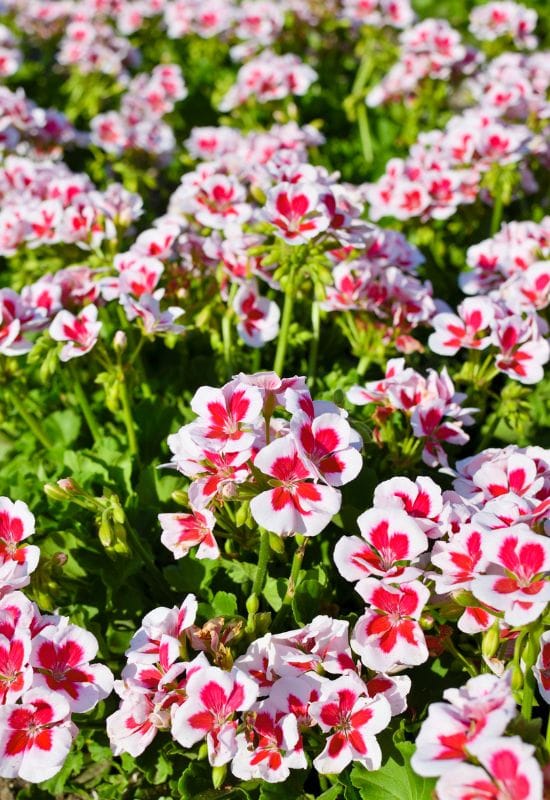
Both in containers and flower beds, geraniums will thrive in the hot summer months with your petunias. Known to deter lots of hungry wildlife, geraniums will keep deer, rabbits, aphids, and cabbage worms at bay.
Having similar requirements, this duo will thrive in each other’s company while delivering sprightly blooms that complement each other well. Geraniums have a variety of cultivars to choose from, with different shades of red, pink, purple, and white that can range in bloom sizes and even offer dramatic bicolored flowers.
6: Candytuft
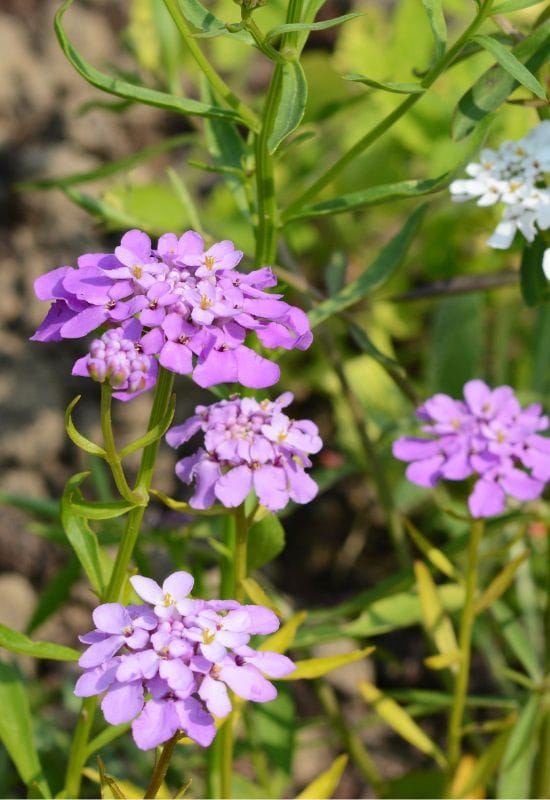
A great option for a perennial companion plant, candytuft is a sun-loving plant with similar growing needs as petunias. Many of the flowering plants on this list will grow well in both containers and gardens, but as a subshrub, I suggest sticking planting candytuft only in flower beds with your petunias.
You can do a layered formation with candytufts behind petunias, or you can plant candytuft between your petunias for a more natural-looking garden. The light colors of candytuft mix well with darker petunias that can bring a little drama to your flower beds.
Candytuft is another great option if you live in areas with wildlife as it is deer and rabbit resistant and will help keep them from munching on your petunias.
7: Daisies
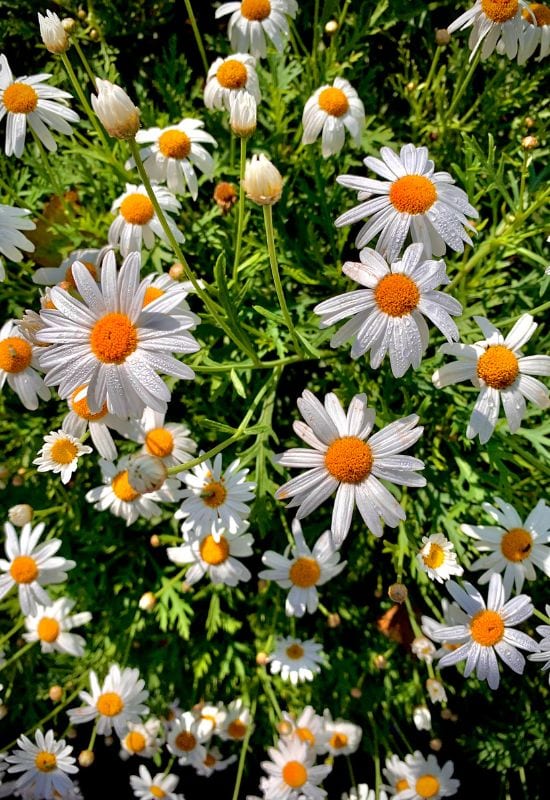
With similar watering needs and soil pH requirements, daisies are easy and fun to grow with petunias. Particularly African daisies, the vibrant blooms pair well when springing up behind your petunias or planted in between them in both containers and flower beds.
With options of oranges, reds, purples, whites, and pinks, you have endless possibilities of color combinations to try with your petunias that add a winsome charm to any place that they are planted together.
Similar to petunias, daisies are tolerant of sub-par soil conditions and are sure to have your garden teeming with butterflies.
8: Calibrachoa (Million Bells) enchanting
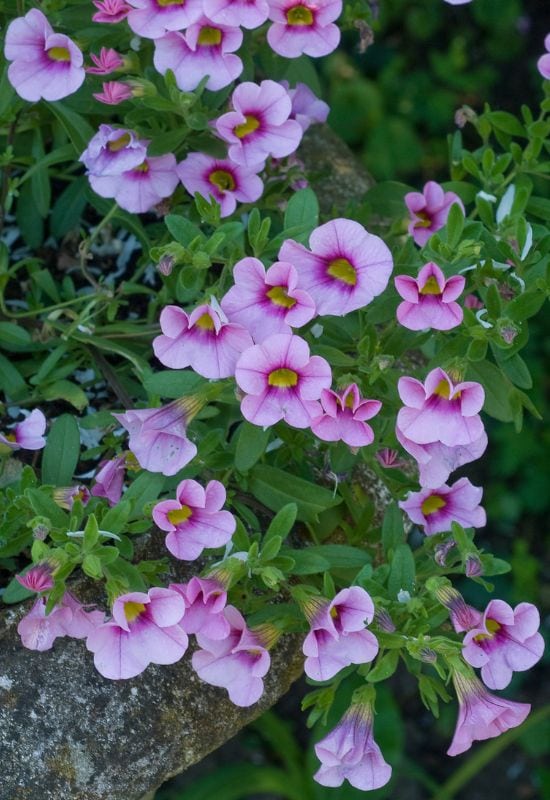
Often mistaken for miniature petunias, calibrachoa are an entirely different species that come in an abundance of striking colors and patterns that make breathtaking hanging baskets and containers for your patio when mixed with petunias.
Having similar light and soil requirements and blooming at the same time, you’ll be seeing vivid blooms of oranges, purples, reds, blues, and many more from spring to the first frost. Not to mention they are also great pollinators, attracting lots of hummingbirds and butterflies.
The contrasting flower sizes also gives your containers a more fresh and natural appeal than the more traditional, prim look of baskets that only hold varieties of petunias.
9: Trailing Verbena
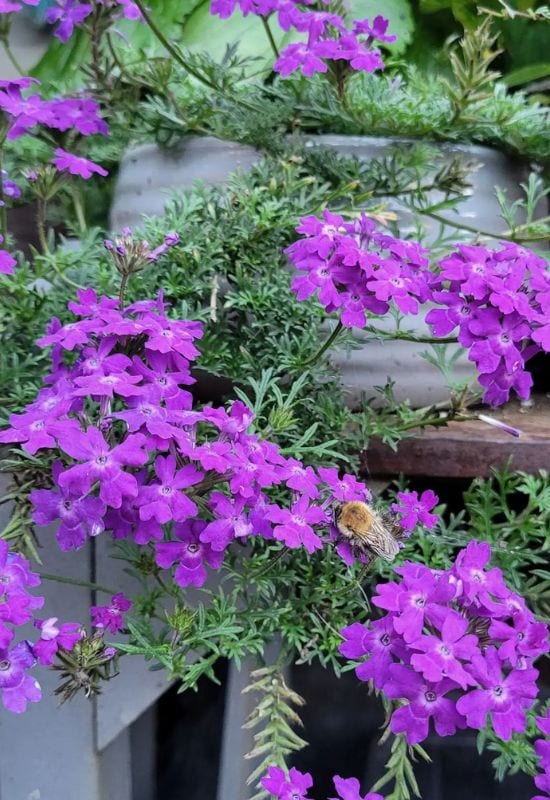
Mixed together in a captivating garden border or as a lush container combo, petunias and trailing verbena grow beautifully together. They are both diseases-resistant plants that thrive in full sun and prefer dryer soil conditions, making them a great pair for low-maintenance containers and gardens. They are also great for natural pest management.
There are so many options for how to plant these, from intermixing petunias and verbena for a more effortless look or planting taller verbena varieties behind your petunias for a more cultivated charm. Even better, you can try out the ultimate trio for containers and hanging baskets: petunias, verbena, and calibrachoa. I promise, you won’t be disappointed.
10: Creeping Jenny
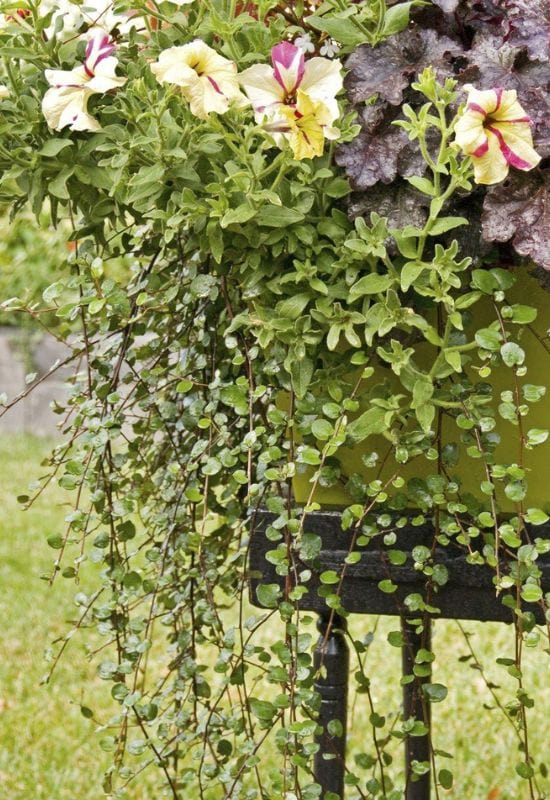
We’ve mentioned a few thriller plants to consider for container and hanging basket planting with petunias, so now we need a spiller plant to complete the trifecta. Creeping jenny is a great choice as a hardy perennial that can grow in a range of climates.
What really catches the eye with creeping jenny is its yellowish-lime foliage that enhances the rich colors of petunias, despite the differing foliage tones.
You do need to keep an eye out when growing creeping jenny as it is very invasive and will expand its territory very quickly if not maintained. Make sure your containers are kept away from the yard or the seeds can sweep in and spread like wildfire.
11: Society Garlic
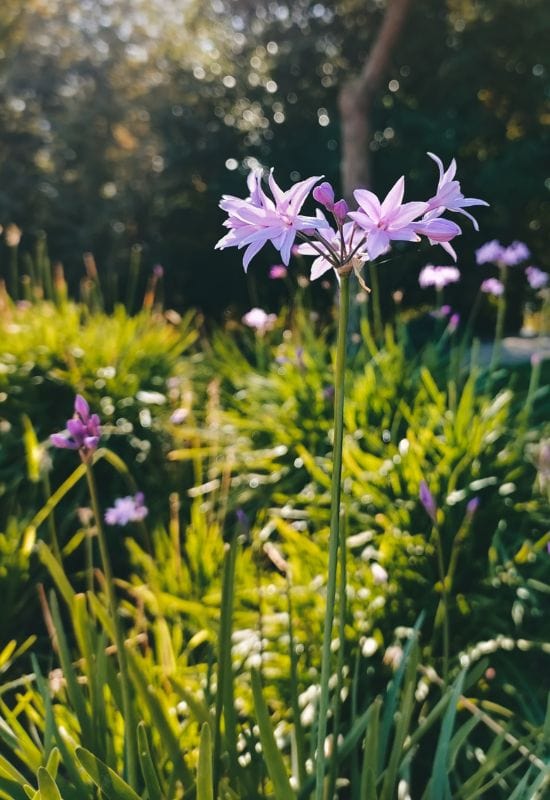
A great option for a low-maintenance garden, society garlic and petunias are both hardy, drought-tolerant plants that thrive in full sun.
Society garlic has tall, reedy leaves and bloom with small clusters of lavender or pink flowers that bring great texture to flower beds when paired with petunias. As a fragrant plant (that does in fact smell like garlic), society garlic helps ward off common garden pests and can be planted in the center of your petunias or intermixed for a more uncultivated look.
12: Guara
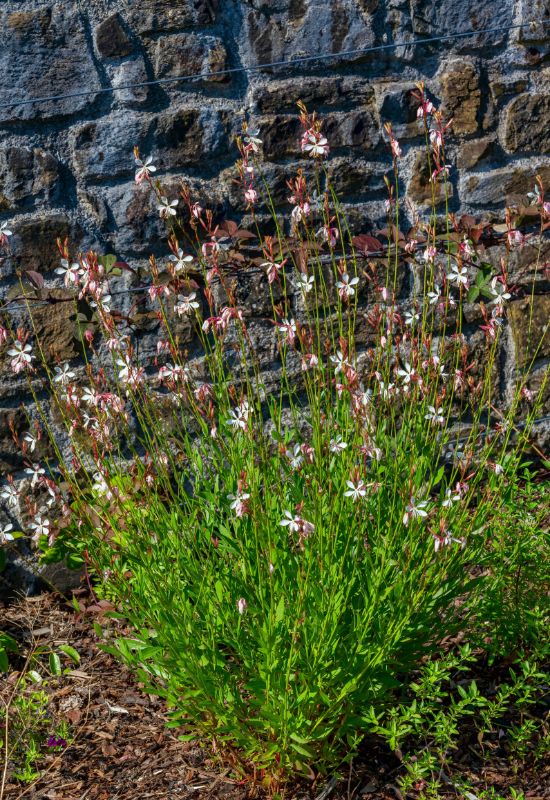
Known as ‘wandflower’ or ‘whirling butterflies’ because of its resemblance to a flock of butterflies surrounding the wiry stems, guara is a delicate flowering perennial that adds a bit of whimsy to your beds or planters when growing behind petunias.
An easy-care option, guara is only available in white or pink blooms but both colors stand out with many different colors of petunias and will draw in plenty of pollinators. Another deer-resistant option, guara is a fun companion plant to keep wildlife out of your landscape.
13: Dusty Miller
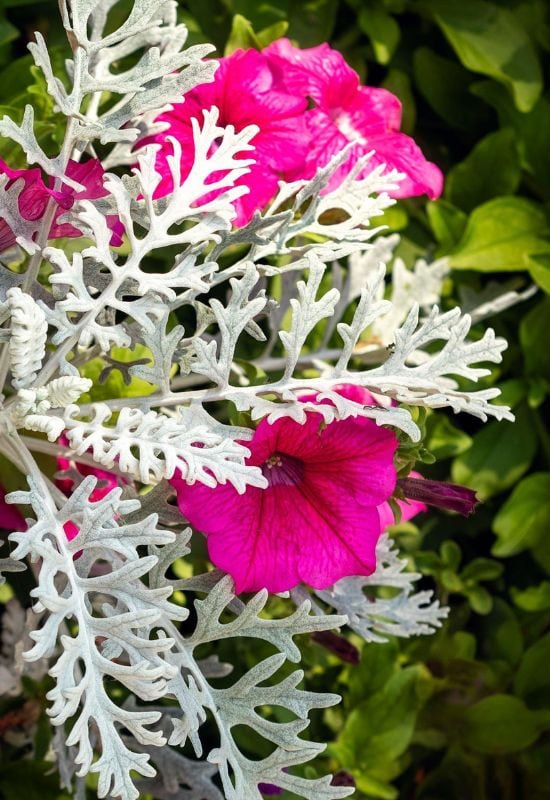
If you’re looking for lots of contrast and texture in your flower beds, dusty miller is the companion plant for your petunias. With silver-colored, bristly foliage, dusty miller makes a striking contrast when planted with bright petunias of purple, blue, or red.
A drought-tolerant, sun-loving plant, dusty miller looks great as garden edging with petunias emerging behind them and actually makes a fun addition to containers as well. Although typically chosen as a companion plant for aesthetic purposes, dusty miller is also deer resistant and is used as nesting material for some bee species, which helps pollination in your garden.
14: Tomatoes

Added to vegetable gardens, petunias will bring in pollinators that help boost vegetable yields and tomatoes will benefit greatly from this. Tomatoes are known for attracting aphids and other pests, but petunias will attract beneficial insects that will feed on these tormentors and are also aphid-repellant.
You can plant your petunias anywhere near tomatoes, but I suggest planting petunias in front of them, at the base, to help hold moisture and ensure that both are getting the full sun that they need.
15: Grapes

When growing grapes, you may run into problems with pests like aphids, spider mites, and moths. Companion planting with petunias can help in discouraging these pests from taking over your orchard. Petunias will also attract bees to increase the yield and add a fun pop of color to the area when planted nearby.
16: Blueberries

Blueberries also benefit from the pollinators that petunias draw in to help increase their yield. Petunias attract insects to eat the pests that will cause damage to your blueberries as well.
There’s also the visual appeal of blueberries bushes with petunias, especially varieties of pink, purple, or red. I suggest planting them behind your petunias because some blueberry varieties can grow up to 12 feet tall.
17: Peas

Peas are vulnerable to the ravenous appetites of aphids, so petunias will take the attention off of peas and give them something else to snack on when you plant them as a barrier around your peas. Because peas aren’t the most attractive vegetable, petunias can help bring some appeal your veggie garden with their brightly colored blooms.
18: Peppers
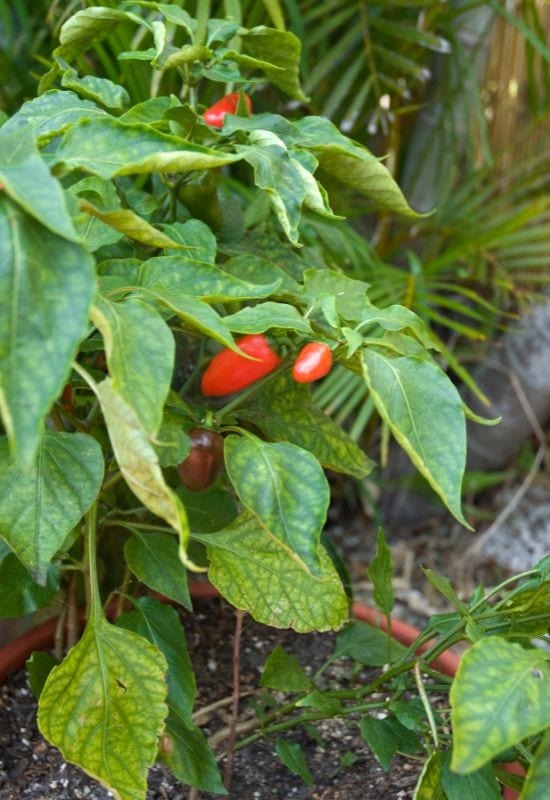
Whether spicy habanero peppers or sweet orange bell peppers, petunias will help attract those bees and hoverflies to pollinate all of your pepper plants. Bordered along your vibrant bell peppers or simply planted nearby, petunias will add some extra pops of color to your garden, while also helping out your harvest.
Plants to Avoid!
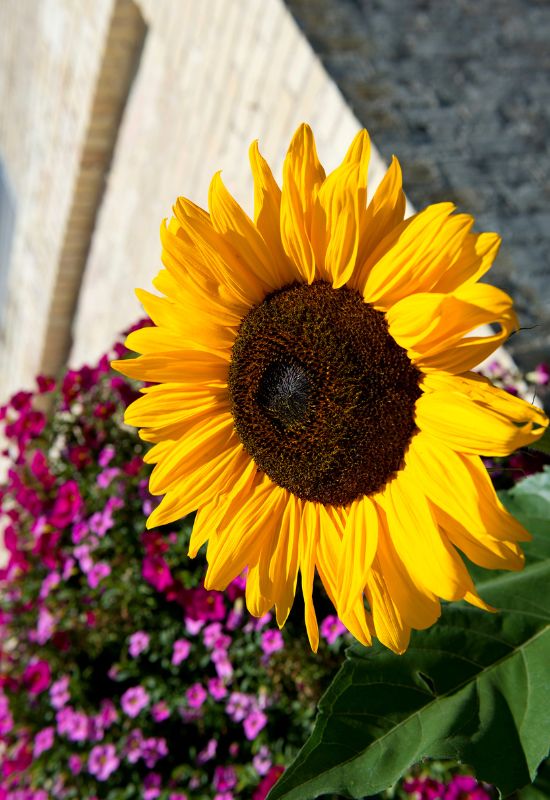
Being sun-loving, drought-tolerant plants, petunias shouldn’t be companion planted with any shade or moisture loving plants. When this happens, one of the plants will typically suffer from inadequate conditions or the maintenance will be a hassle as you try to make it work.
Shade-loving plants will dry out very quickly and die when put in an area with full sun, so you should avoid plants like ferns and begonias.
Moisture loving plants will wilt and die if kept in dry soil and while petunias can handle some moisture, they much prefer dryer environments. And I know that no one wants to go around watering each individual plant in their garden, so stay away from plants like irises and calla lilies.
You should also avoid these specific plants because even though they don’t prefer moisture or shade, they either take away sun and nutrients or have different soil requirements than petunias:
Final Thoughts
This list only scratches the surface of possible companion plants for your petunias as there are countless candidates to choose from, but you can always refer back to this guide for a sure-fire pairing.
Just remember that choosing a plant with similar light, soil, and moisture requirements as petunias is the most important for both plants to flourish and it also helps to know which plants are hardy to the region that you live.
Companion planting with petunias leaves a lot of room for originality in plant choice, arrangement, and overall style, so don’t be afraid to experiment with different colors, textures and designs. Now foster that creativity and get planting!

Written By
Adriano Bulla
After many years as an academic in London, Adriano Bulla became a writer, publishing books like A History of Gardening, Organic Gardening and Elements of Garden Design; he then decided to become a gardener, following his childhood dream, and has been following his dream writing and gardening professionally in Southern Europe, where he has specialized in new and innovative organic gardening fields and techniques, like permaculture, regenerative agriculture, food forests and hydroponics.
